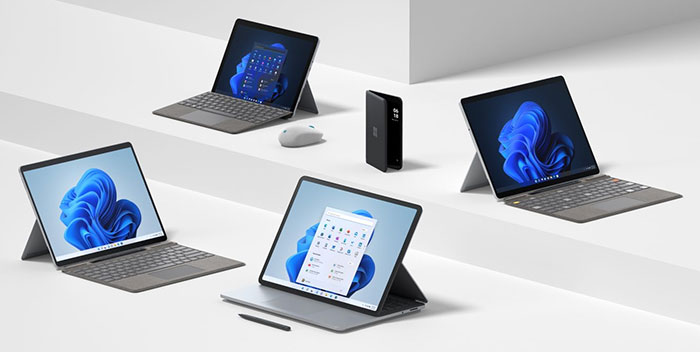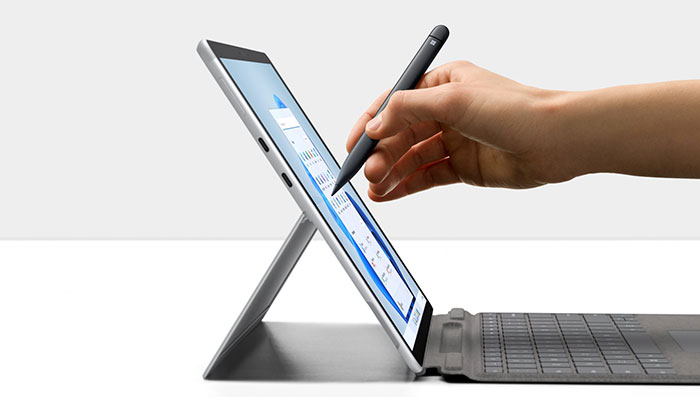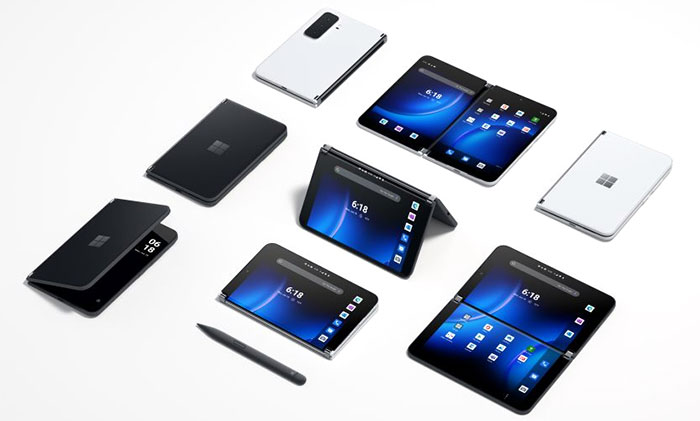At the special Microsoft Event last night, there were eight new Surface devices and accessories built for Windows 11 unveiled. Earlier we enjoyed a hard stare at the Surface Laptop Studio, and below we are going to look through the rest of the Surface offerings.

Microsoft Surface Pro 8
Microsoft's Surface Pro 8 is the latest iteration of the Surface device that started it all. From Microsoft's claim's it certainly hasn't stood still, with this being the "most significant leap forward since the Pro 3," and is the first Surface to be built on Intel's Evo platform.
Considering performance first, the Surface Pro 8 is said to be more than twice as fast as Pro 7 – with its choice of 11th Gen Intel Core processors (max spec Core i7-1185G7, 12-28W, 10nm SuperFin, 4C/8T, 4.8GHz turbo). Onboard Intel Iris Xe graphics are present.
Another important upgrade is with the screen. With this latest generation Microsoft has shrunk the bezels and users benefit from a 13-inch PixelSense display with 2880 x 1920 pixels, up to 120Hz refresh, Dolby Vision supporting, Adaptive Colour Technology screen with 10 point multi-touch and GPU Ink Acceleration. Users can buy these hybrid machines with up to 32GB of RAM, 1TB SSD (plus 128 or 256GB removable SSD).

Other specs worth mentioning are the 5MP front-facing camera, a 10MP-4K rear-facing camera, twin USB-C Thunderbolt 4 ports, Dual far-field Studio Mics, 2W stereo speakers with Dolby Atmos, Wi-Fi 6: 802.11ax, Bluetooth 5.1, and the typical battery life of 16 hours claimed. Microsoft's Surface Pro 8 remains easily portable with its 287 x 208 x 9.3mm dimensions and 889g weight. Most people will want to add the new Surface Pro Signature Keyboard, adding weight and thickness with its bonuses of traditional laptop productivity (on a desk) and portable screen protection.
Surface Pro 8 starts at US$1,099.99 and is available for pre-order in select markets today.
Surface supporting cast
Microsoft's Surface Pro X reveal was of what I would consider a minor update. It is the same thin, light, and LTE-connected Surface Pro X, running on our Microsoft SQ2 ARM silicon that we saw last year, but now it comes with Windows 11 and 64-bit emulation built in – as well as a new Wi-Fi only SKU with keener pricing. The new model of the Surface Pro X starts at $899.99 and is pre-orderable immediately.

The highly portable and compact Surface Go 3 is more interesting as, though it is similar in many ways to its predecessor, it now packs in much more powerful processing options.
So the Surface Go, is built around the same 10.5-inch 3:2 1920 x 1280 pixels touchscreen as the predecessor, the same cameras, speakers, ports and with the same dimensions. However, if the slowness of this compact device previously put you off, the new dual-core 10th Gen Intel Core i3-10100Y processor options might appeal as it is claimed to be up to 60 per cent faster than its predecessor.
Surface Go 3 with Wi-Fi starts at US$399.99 and is available for pre-order today in select markets. LTE models will be available in the coming months.
Microsoft Surface Duo 2
Microsoft's dual screen folding Android portable was one of the high points of the event last night. It wasn't a surprise as the specs are very close to those leaked, but in fulfilling what the digital prophets had foretold it now checks a lot more boxes that a premium design/priced Surface smartphone should check.
The new Surface Duo 2 has the following key improvements that bring it head and shoulders above the first version; the Qualcomm Snapdragon 888 5G Mobile Platform, and the triple lens rear camera system. Additionally, Microsoft has fitted larger AMOLED displays, implemented 5G connectivity (Nano + eSIM), NFC, stereo speakers, 8GB of RAM (up from 6GB) and a new 'Glance Bar' for notifications on the device spine. You also get to choose whether you want the device is Glacier or Obsidian finishes.

One of the few negative points of the Duo 2 is that, while the device is shorter in length and width, it is a tad thicker at 5.5mm open/11.0mm closed compared with the predecessor (4.8mm/9.9mm), and it is 34g weightier at 284g, too.
Surface Duo 2 starts at $1499.99, and you can pre-order today, depending on your location.













